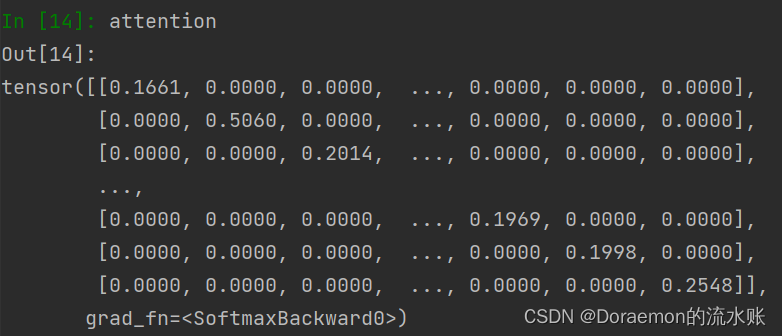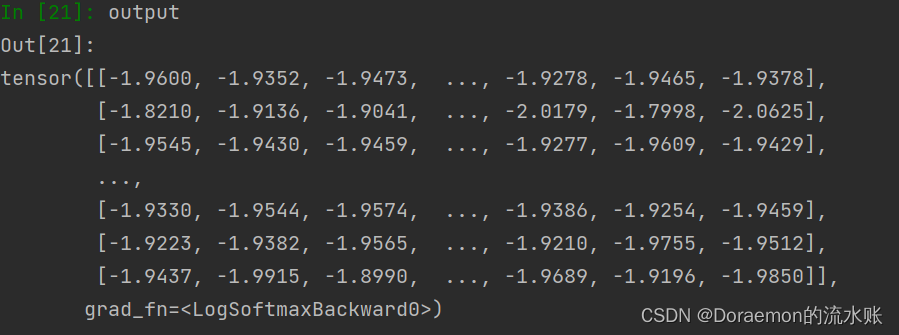近期的学习中,总会遇到一个问题:好不容易弄懂了一个个数学公式,但是真正在实现的时候不知道代码怎么去写。因此,参考已有的模型代码区复现分析变得重要起来,今天选择了一个相对简单的GAT模型,结合已经掌握的GAT相关知识,从源码级别DEBUG走起。
前置工作
代码结构树
pyGAT
├── data
│ └── cora
│ ├── README
│ ├── cora.cites
│ └── cora.content
├── LICENSE
├── README.md
├── layers.py
├── models.py
├── requirements.txt
├── train.py
├── utils.pyCora数据集简介
cora.content中包含了七类机器学习的论文,共计2708行,每行以ID起始,中间是1433维的one-hot特征,最后一列是对应的类别
cora.cites中每一行由两个数字构成,第一个数字代表被引用论文的ID。第二个数字代表引用前面论文的那篇论文的ID
加载数据

adj是全部文章的引用关系构成的图做过归一化后的邻接矩阵(2708*2708),features为2708篇文章每篇的1433个特征,idx_test,idx_train,idx_val分别是划分出来的测试集训练集与验证集,labels为文章的分类标签
模型定义
GAT初始化
在model处单步步入,看GAT模型类构建的方法
models.py
class GAT(nn.Module):
def __init__(self, nfeat, nhid, nclass, dropout, alpha, nheads):
"""Dense version of GAT."""
super(GAT, self).__init__()
self.dropout = dropout
self.attentions = [GraphAttentionLayer(nfeat, nhid, dropout=dropout, alpha=alpha, concat=True) for _ in range(nheads)]
for i, attention in enumerate(self.attentions):
self.add_module('attention_{}'.format(i), attention)
self.out_att = GraphAttentionLayer(nhid * nheads, nclass, dropout=dropout, alpha=alpha, concat=False) # 第二层(最后一层)的attention layer
def forward(self, x, adj):
x = F.dropout(x, self.dropout, training=self.training)
x = torch.cat([att(x, adj) for att in self.attentions], dim=1) # 将每层attention拼接
x = F.dropout(x, self.dropout, training=self.training)
x = F.elu(self.out_att(x, adj)) # 第二层的attention layer
return F.log_softmax(x, dim=1)定义第一层GraphAttentionLayer
在第7行,建立了第一个层GraphAttentionLayer,其中nheads参数表示了这是一个多头的GAT

接着定义了第一层的GraphAttentionLayer,步入里面,看其中的init方法
layers.py
def __init__(self, in_features, out_features, dropout, alpha, concat=True):
super(GraphAttentionLayer, self).__init__()
self.dropout = dropout
self.in_features = in_features
self.out_features = out_features
self.alpha = alpha
self.concat = concat
self.W = nn.Parameter(torch.empty(size=(in_features, out_features)))
nn.init.xavier_uniform_(self.W.data, gain=1.414)
self.a = nn.Parameter(torch.empty(size=(2*out_features, 1))) # concat(V,NeigV)
nn.init.xavier_uniform_(self.a.data, gain=1.414)
self.leakyrelu = nn.LeakyReLU(self.alpha)首先是对公式中的W的定义,in_features, out_features分别是(1433,8),也就是说W是将1433维的特征转换为8维
接着定义了α向量,作为Whi与Whj向量拼接后的系数,因为是横向拼接所以2*out_features
最后定义了leakyrelu激活函数


步出GraphAttentionLayer,进入class GAT(nn.Module)line8的循环,因为样例中定义了8个head,因此循环了8次定义了8个GraphAttentionLayer
self.attentions = [GraphAttentionLayer(nfeat, nhid, dropout=dropout, alpha=alpha, concat=True) for _ in range(nheads)]
定义第二层GraphAttentionLayer
回到class GAT(nn.Module)的init中line11,对第二层(最后一层)GraphAttentionLayer进行定义
self.out_att = GraphAttentionLayer(nhid * nheads, nclass, dropout=dropout, alpha=alpha, concat=False)这里的nhid * nheads为8*8,也就是隐层维度与注意力头数相乘,nclass=7是最后要映射到的7个类别上,对于这一层的GraphAttentionLayer内部同上,不再赘述
模型训练
进行初始化
在train.py中有对cuda的定义,如果设置了CUDA使用GPU算的时要转换为Variable,因为variable是一种可以不断变化的变量,符合反向传播 而tensor不能反向传播
Variable计算时,会逐步生成计算图,这个图将所有的计算节点都连接起来,最后进行loss反向传播时,一次性将所有Variable里的梯度计算出来,然而tensor没有这个能力
train.py
if args.cuda:
model.cuda()
features = features.cuda()
adj = adj.cuda()
labels = labels.cuda()
idx_train = idx_train.cuda()
idx_val = idx_val.cuda()
idx_test = idx_test.cuda()
features, adj, labels = Variable(features), Variable(adj), Variable(labels)跟进train()=>model(features, adj)
train.py
def train(epoch):
t = time.time()
model.train()
optimizer.zero_grad()
output = model(features, adj) # GAT模块
loss_train = F.nll_loss(output[idx_train], labels[idx_train])
acc_train = accuracy(output[idx_train], labels[idx_train])
loss_train.backward()
optimizer.step()再跟进model(features, adj)中的forward
models.py
def forward(self, x, adj):
x = F.dropout(x, self.dropout, training=self.training)
x = torch.cat([att(x, adj) for att in self.attentions], dim=1) # 将每层attention拼接
x = F.dropout(x, self.dropout, training=self.training)
x = F.elu(self.out_att(x, adj)) # 第二层的attention layer
return F.log_softmax(x, dim=1)也就是在定义好的模型上先进行前向传播,先是第一层的GraphAttentionLayer,在上面line3的self.attentions中步入
走进第一层
layers.py
def forward(self, h, adj):
Wh = torch.mm(h, self.W) # h.shape: (N, in_features), Wh.shape: (N, out_features)
a_input = self._prepare_attentional_mechanism_input(Wh) # 每一个节点和所有节点,特征。(Vall, Vall, feature)
e = self.leakyrelu(torch.matmul(a_input, self.a).squeeze(2))
# 之前计算的是一个节点和所有节点的attention,其实需要的是连接的节点的attention系数
zero_vec = -9e15*torch.ones_like(e)
attention = torch.where(adj > 0, e, zero_vec) # 将邻接矩阵中小于0的变成负无穷
attention = F.softmax(attention, dim=1) # 按行求softmax。 sum(axis=1) === 1
attention = F.dropout(attention, self.dropout, training=self.training)
h_prime = torch.matmul(attention, Wh) # 聚合邻居函数
if self.concat:
return F.elu(h_prime) # elu-激活函数
else:
return h_prime先看上面line2的h和W,不难看出是通过W参数矩阵对1433维度特征的压缩

再看上面line3处的self._prepare_attentional_mechanism_input,跟进后发现比较复杂,还好作者给了解释和说明
layers.py
def _prepare_attentional_mechanism_input(self, Wh):
N = Wh.size()[0] # number of nodes
# Below, two matrices are created that contain embeddings in their rows in different orders.
# (e stands for embedding)
# These are the rows of the first matrix (Wh_repeated_in_chunks):
# e1, e1, ..., e1, e2, e2, ..., e2, ..., eN, eN, ..., eN
# '-------------' -> N times '-------------' -> N times '-------------' -> N times
#
# These are the rows of the second matrix (Wh_repeated_alternating):
# e1, e2, ..., eN, e1, e2, ..., eN, ..., e1, e2, ..., eN
# '----------------------------------------------------' -> N times
#
Wh_repeated_in_chunks = Wh.repeat_interleave(N, dim=0) # 复制
Wh_repeated_alternating = Wh.repeat(N, 1)
# Wh_repeated_in_chunks.shape == Wh_repeated_alternating.shape == (N * N, out_features)
# The all_combination_matrix, created below, will look like this (|| denotes concatenation):
# e1 || e1
# e1 || e2
# e1 || e3
# ...
# e1 || eN
# e2 || e1
# e2 || e2
# e2 || e3
# ...
# e2 || eN
# ...
# eN || e1
# eN || e2
# eN || e3
# ...
# eN || eN
all_combinations_matrix = torch.cat([Wh_repeated_in_chunks, Wh_repeated_alternating], dim=1)
# all_combinations_matrix.shape == (N * N, 2 * out_features)
return all_combinations_matrix.view(N, N, 2 * self.out_features)为了计算两个相邻节点的attention,这里面并没有提取相邻节点,而是把全局所有的N个节点都一一配对,出了N*N个对,得到了如下的向量

也就是N*N,2*output_feature,也就是所有节点两两拼接的feature,return到forward(self, h, adj)的line3的a_input
a_input = self._prepare_attentional_mechanism_input(Wh)但是我们要明确的是,需要求的是相邻节点之间的attention,刚刚上面的只是一个全局的初始化
那么,怎么定义相邻节点的attention呢?
先别着急,接着看,line4其实就是eij
e = self.leakyrelu(torch.matmul(a_input, self.a).squeeze(2))
接着初始化了一个负无穷的zero_vec矩阵
zero_vec = -9e15*torch.ones_like(e)因为之前定义过一个叫adj的邻接矩阵,储存了节点的相连关系,所以对attention是这样定义的
attention = torch.where(adj > 0, e, zero_vec)通过这一步,将邻接矩阵adj中大于0(有边的)置为刚刚定义的eij,小于0的变成负无穷,可以看一下效果

但是这并不是最终attention的系数,还要通过softmax归一化

归一化之后的attention,每一个节点对行求和之后系数是1,也就很好的说明了相邻节点对于目标节点的权重系数之和为1

求完了attention之后,来求

也就是
h_prime = torch.matmul(attention, Wh) # 聚合邻居函数得到了表示2708个节点隐层的矩阵

又因为定义了8个attention的head,这里循环了8次使用
x = torch.cat([att(x, adj) for att in self.attentions], dim=1) # 将8层attention拼接也就是

好,Dropout之后,到此,第一层就结束了
走进第二层
再回到model(features, adj)中的forward的line5
x = F.elu(self.out_att(x, adj))也就是第二层的GraphAttentionLayer,h是刚刚拼好的x

因为最后是7分类,所以这里W的维度有所不同

其他部分没有什么变化,第二层最终输出的就是,接上一个softmax输出为output

再贴一遍train
train.py
def train(epoch):
t = time.time()
model.train()
optimizer.zero_grad()
output = model(features, adj) # GAT模块
loss_train = F.nll_loss(output[idx_train], labels[idx_train])
acc_train = accuracy(output[idx_train], labels[idx_train])
loss_train.backward()
optimizer.step()上面的line6的nll_loss怎么理解?其实就是nn.CrossEntropyLoss

再loss_train.backward()进行反向传播
打印output,在7列中哪个值最大,也就最后可能是哪一类标签的节点

这大概也就把GAT的源码部分撸完了,周末快乐!
参考:
GAT源码剖析_行走天涯的豆沙包的博客-CSDN博客_gat源码























 4058
4058











 被折叠的 条评论
为什么被折叠?
被折叠的 条评论
为什么被折叠?








